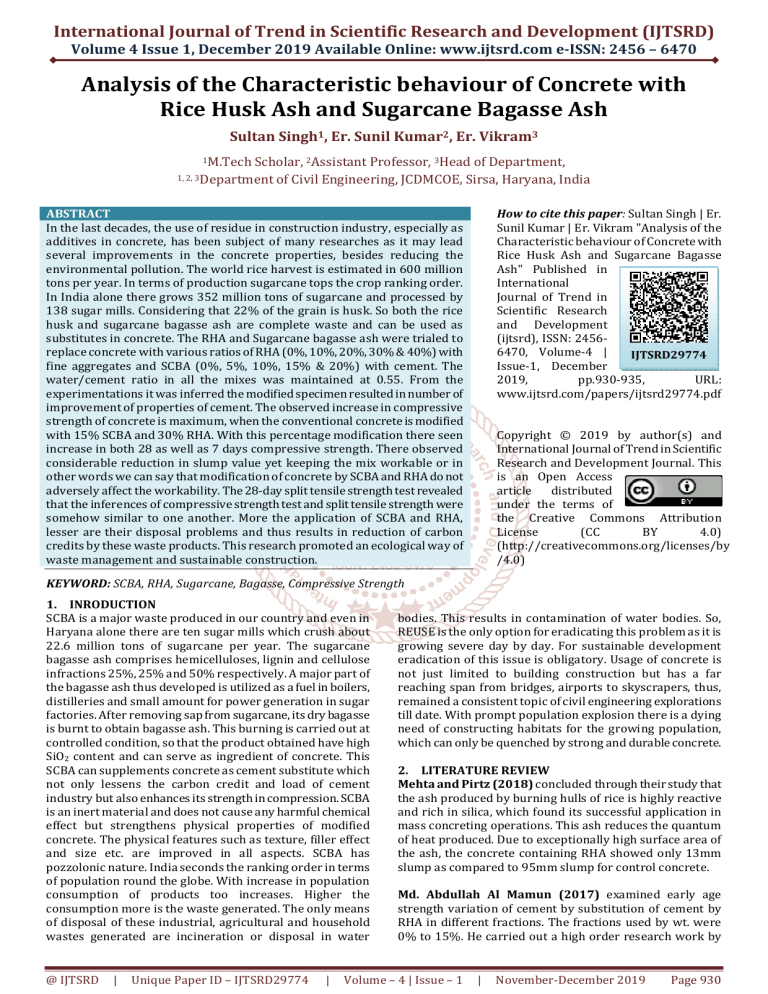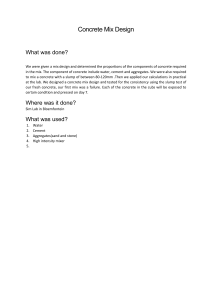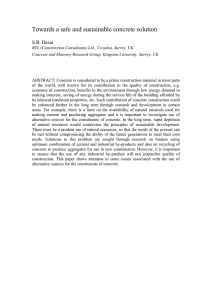
International Journal of Trend in Scientific Research and Development (IJTSRD)
Volume 4 Issue 1, December 2019 Available Online: www.ijtsrd.com e-ISSN: 2456 – 6470
Analysis of the Characteristic behaviour of Concrete with
Rice Husk Ash and Sugarcane Bagasse Ash
Sultan Singh1, Er. Sunil Kumar2, Er. Vikram3
1M.Tech
Scholar, 2Assistant Professor, 3Head of Department,
1, 2, 3Department of Civil Engineering, JCDMCOE, Sirsa, Haryana, India
How to cite this paper: Sultan Singh | Er.
Sunil Kumar | Er. Vikram "Analysis of the
Characteristic behaviour of Concrete with
Rice Husk Ash and Sugarcane Bagasse
Ash" Published in
International
Journal of Trend in
Scientific Research
and Development
(ijtsrd), ISSN: 24566470, Volume-4 |
IJTSRD29774
Issue-1, December
2019,
pp.930-935,
URL:
www.ijtsrd.com/papers/ijtsrd29774.pdf
ABSTRACT
In the last decades, the use of residue in construction industry, especially as
additives in concrete, has been subject of many researches as it may lead
several improvements in the concrete properties, besides reducing the
environmental pollution. The world rice harvest is estimated in 600 million
tons per year. In terms of production sugarcane tops the crop ranking order.
In India alone there grows 352 million tons of sugarcane and processed by
138 sugar mills. Considering that 22% of the grain is husk. So both the rice
husk and sugarcane bagasse ash are complete waste and can be used as
substitutes in concrete. The RHA and Sugarcane bagasse ash were trialed to
replace concrete with various ratios of RHA (0%, 10%, 20%, 30% & 40%) with
fine aggregates and SCBA (0%, 5%, 10%, 15% & 20%) with cement. The
water/cement ratio in all the mixes was maintained at 0.55. From the
experimentations it was inferred the modified specimen resulted in number of
improvement of properties of cement. The observed increase in compressive
strength of concrete is maximum, when the conventional concrete is modified
with 15% SCBA and 30% RHA. With this percentage modification there seen
increase in both 28 as well as 7 days compressive strength. There observed
considerable reduction in slump value yet keeping the mix workable or in
other words we can say that modification of concrete by SCBA and RHA do not
adversely affect the workability. The 28-day split tensile strength test revealed
that the inferences of compressive strength test and split tensile strength were
somehow similar to one another. More the application of SCBA and RHA,
lesser are their disposal problems and thus results in reduction of carbon
credits by these waste products. This research promoted an ecological way of
waste management and sustainable construction.
Copyright © 2019 by author(s) and
International Journal of Trend in Scientific
Research and Development Journal. This
is an Open Access
article
distributed
under the terms of
the Creative Commons Attribution
License
(CC
BY
4.0)
(http://creativecommons.org/licenses/by
/4.0)
KEYWORD: SCBA, RHA, Sugarcane, Bagasse, Compressive Strength
1. INRODUCTION
SCBA is a major waste produced in our country and even in
Haryana alone there are ten sugar mills which crush about
22.6 million tons of sugarcane per year. The sugarcane
bagasse ash comprises hemicelluloses, lignin and cellulose
infractions 25%, 25% and 50% respectively. A major part of
the bagasse ash thus developed is utilized as a fuel in boilers,
distilleries and small amount for power generation in sugar
factories. After removing sap from sugarcane, its dry bagasse
is burnt to obtain bagasse ash. This burning is carried out at
controlled condition, so that the product obtained have high
SiO2 content and can serve as ingredient of concrete. This
SCBA can supplements concrete as cement substitute which
not only lessens the carbon credit and load of cement
industry but also enhances its strength in compression. SCBA
is an inert material and does not cause any harmful chemical
effect but strengthens physical properties of modified
concrete. The physical features such as texture, filler effect
and size etc. are improved in all aspects. SCBA has
pozzolonic nature. India seconds the ranking order in terms
of population round the globe. With increase in population
consumption of products too increases. Higher the
consumption more is the waste generated. The only means
of disposal of these industrial, agricultural and household
wastes generated are incineration or disposal in water
@ IJTSRD
|
Unique Paper ID – IJTSRD29774
|
bodies. This results in contamination of water bodies. So,
REUSE is the only option for eradicating this problem as it is
growing severe day by day. For sustainable development
eradication of this issue is obligatory. Usage of concrete is
not just limited to building construction but has a far
reaching span from bridges, airports to skyscrapers, thus,
remained a consistent topic of civil engineering explorations
till date. With prompt population explosion there is a dying
need of constructing habitats for the growing population,
which can only be quenched by strong and durable concrete.
2. LITERATURE REVIEW
Mehta and Pirtz (2018) concluded through their study that
the ash produced by burning hulls of rice is highly reactive
and rich in silica, which found its successful application in
mass concreting operations. This ash reduces the quantum
of heat produced. Due to exceptionally high surface area of
the ash, the concrete containing RHA showed only 13mm
slump as compared to 95mm slump for control concrete.
Md. Abdullah Al Mamun (2017) examined early age
strength variation of cement by substitution of cement by
RHA in different fractions. The fractions used by wt. were
0% to 15%. He carried out a high order research work by
Volume – 4 | Issue – 1
|
November-December 2019
Page 930
International Journal of Trend in Scientific Research and Development (IJTSRD) @ www.ijtsrd.com eISSN: 2456-6470
using high performance concrete. The experimentations
were carried out in both laboratories as well as in field, so
that real time behavior was diagnosed efficiently. Outcomes
were quite remarkable in which more controlled mix can be
developed by this technique. Setting time was substantially
reduced but percentage replacement can be raised without
harming properties of concrete. Great results were obtained
by working out results of strength in compression. Not only
this but also reduced porosity and made the mix
impermeable, improved penetration depth and reduced the
quantity of cement to be used.
M. B. Prajapati (2016) carried out experimentation for
validation of RHA as a partial substitute of cement. Not only
this but also he used a little content of Steel fiber too with
RHA. The experimental investigations were performed on
M30 concrete with varying proportion of RHA as well as
steel fiber. He carried out test for 7; 28 as well as 56 days.
3. MATERIAL & EXPERIMENTATIONS
Properties of Material used
The important ingredients used in preparing concrete mix
are discussed and detailed below with their important
characteristic properties. These properties allow the
engineer to opt the correct material for right situation and
suitability
Cement
Cement is a key component of concrete and in technical
terms it is a calcareous or siliceous crystalline compound
which is featured with special hydraulic properties. The four
key compounds necessary for production of cement are
termed as Bogue’s Compounds and these are namely C3S or
Tri-calcium silicate, Tetra calcium alumino ferrite (C4AF),
C2S or Di-calcium silicate, Tri-calcium aluminate (C3A),
where Calcium oxide is abbreviated by C, S stands for silica
(SiO2), A stands for Aluminum oxide (Al2O3) and F for Ferric
Oxide (Fe2O3). Out of these four compounds C3S and C2S
are the compounds which are the major constituents (about
70%) and also significant strength contributors to the
cement.
Coarse aggregates
The aggregates with size greater 4.75 mm are termed as
Coarse aggregates. These aggregates retain on 4.75 mm
sieve. There are different sorts of coarse aggregates available
in market, namely:
Uncrushed Stone or Gravel: These are bigger size coarse
aggregates and formed due to natural degeneration of
rock.
Crushed Stone or Gravel: These are finer than uncrushed
gravel and formed by their decomposition.
Partially Crushed Stone or Gravel: These are formed by
blending Uncrushed and Crushed Stone or Gravel
together.
Fine aggregates
The aggregates with size less than 4.75 mm are termed as
Fine aggregates. These aggregates pass through 4.75 mm
sieve. There are different sorts of fine aggregates available in
market, namely:
Natural Sand: These are deposited at river banks or
entrapped in glaciers and formed due to natural
degeneration of rock.
Crushed Stone Sand: These are finer aggregates and
formed by decomposition of hard stone.
Crushed Gravel Sand: These are formed by crushing of
natural gravel
Workability of concrete
In simpler words the dexterity of working with green
concrete is termed as “Workability” and in technical terms it
is that property of fresh concrete or mortar which governs
the ease and evenness with which it can be mixed, placed,
compacted, and finished. Workability is not merely a
characteristic of the concrete, rather it a major property that
govern the nature of the application of concrete mix. The
durability (or life) and strength of hardened concrete in turn
depends on it. Different test methods are opted to check the
workability. Some of the tests commonly used in field as well
as laboratory to find workability are: Slump Test
Compacting Factor Test
Vee-Bee Test
Flow Table Test
Compressive strength of concrete
Before testing the quantities of various ingredients and
modifiers like cement, coarse aggregates (20 mm and 10
mm), fine aggregates, SCBA, RHA and water were weighed
and jotted down separately. Firstly, the properly graded
SCBA and cement were blended uniformly in dry state. Then
to this dry mix fine aggregates and RHA were also mixed
properly in requisite proportions. After that coarse
aggregates were added uniformly to give rigid skeleton to
the mix.
Flexural Strength test
To find flexural tensile strength of concrete, beam of
dimensions (100 x 100 x 500 mm) are prepared. Then the
sample is tested using Universal Testing machine with 3
point load at a loading rate of 180Kg/min. up to failure.
Flexural strength=
4. RESULTS
Designation of Concrete mix:
Strength of specimen in Compression was calculated by
testing cubical specimen each of edge 150 mm. This cubical
specimen was casted in a mould which greases its sides from
oil before pouring the concrete. The varying proportions of
modifier and designation of the mix are tabulated in the
successive table.
Designation of concrete mixture
Mix
S1
S2
S3
S4
S5
@ IJTSRD
|
RHA (%)
Unique Paper ID – IJTSRD29774
0
|
SCBA (%)
0
5
10
15
20
Cement (%)
100
95
90
85
80
Volume – 4 | Issue – 1
|
November-December 2019
Page 931
International Journal of Trend in Scientific Research and Development (IJTSRD) @ www.ijtsrd.com eISSN: 2456-6470
S6
S7
S8
S9
S10
S11
S12
S13
S14
S15
S16
S17
S18
S19
S20
S21
S22
S23
S24
S25
10
20
30
40
0
5
10
15
20
0
5
10
15
20
0
5
10
15
20
0
5
10
15
20
90
85
80
75
70
80
75
70
65
60
70
65
60
55
50
60
55
50
45
40
Test for Workability of concrete:
Results of workability test of concrete
Specimen SCBA (%) RHA (%) Slump (in mm)
S0
0
0
70
S1
5
10
55
S2
10
20
60
S3
15
30
65
S4
20
40
55
80
70
SLUMP (mm)
60
50
40
30
20
10
Workability Test
Test for Compressive Strength:
Results of test carried out on different specimens for Compressive strength are tabulated as below:
@ IJTSRD
|
Mix
SCBA (%)
S0
S1
S2
0
Test results for compressive strength
fck,avg (N/mm2)
RHA (%)
7 days Mean Value 28 days
22.01
32.70
0
22.63
22.37
32.90
23.06
32.80
Unique Paper ID – IJTSRD29774
|
Volume – 4 | Issue – 1
|
Mean Value
32.80
November-December 2019
Page 932
International Journal of Trend in Scientific Research and Development (IJTSRD) @ www.ijtsrd.com eISSN: 2456-6470
S3
S4
S5
S6
S7
S8
S9
S10
S11
S12
S13
S14
5
10
10
20
15
30
20
40
21.87
22.51
22.92
21.43
22.05
23.53
23.90
23.80
23.70
20.14
20.79
22.23
22.44
22.00
23.70
20.91
33.10
33.17
34.79
34.55
33.59
34.19
35.79
35.83
35.21
33.80
32.84
32.79
33.68
34.11
35.61
33.14
Compressive Strength (N/mm2)
40
35
30
25
20
15
10
5
0
Compressive Strength Test
Split Tensile Test
Results of test carried out on different specimens for split tensile strength are tabulated as below:
Split tensile test
Sample
S0
S1
S2
S3
S4
Split Tensile strength in MPa
2.80
2.86
2.93
3.97
3.04
Series 1
4.5
4
3.5
3
2.5
2
1.5
1
0.5
Fig. 4.3 Split Tensile Test
@ IJTSRD
|
Unique Paper ID – IJTSRD29774
|
Volume – 4 | Issue – 1
|
November-December 2019
Page 933
International Journal of Trend in Scientific Research and Development (IJTSRD) @ www.ijtsrd.com eISSN: 2456-6470
Test for Strength in Flexure
Results of test carried out on different samples for flexural strength are tabulated as below: Flexural Strength (F.S.)
Flexural Strength Test
Sample
S0
S1
S2
S3
7 Days
4.20
4.56
4.70
4.97
28 Days
5.85
6.20
6.40
6.70
S4
4.40
6.75
8
7
flexural
Strength
6
5
4
3
2
1
Flexure Test
0
5. Conclusion
In this chapter, the whole research is concluded with all its
major pros and cons. From the experimentations carried in
the previous chapter it was inferred the modified specimen
resulted in number of improvement of properties of cement.
The conclusions drawn are briefed as below:
A. Observations drawn from compressive strength test
showed that the observed increase in compressive
strength of concrete is maximum when the conventional
concrete is modified with 15% SCBA and 30% RHA.
B. With this percentage modification there seen increase in
both 28 as well as 7 days compressive strength.
C.
The modified sample had not any considerable effect on
7 day flexural strength but improved 28 days flexural
strength to a promising value.
D. There observed considerable reduction in slump value
yet keeping the mix workable or in other words we can
say that modification of concrete by SCBA and RHA do
not adversely affect the workability.
E.
The 28-day split tensile strength was conducted on
different concrete mixes under different restraints and
conditions. From the results it was inferred that the
@ IJTSRD
|
Unique Paper ID – IJTSRD29774
|
inferences of compressive strength test and split tensile
strength were somehow similar to one another.
F.
More the application of SCBA and RHA lesser be their
disposal problems and thus results in reduction of
carbon credits by these waste products.
G. This research promoted an ecological way of waste
management. Yet both RHA and SCBA are biodegradable waste but need ample time for their
decomposition. Meanwhile, serve as rotten or disease
causing waste product.
H. Not only improvement in engineering properties of
concrete this is an economical as well as ecological
modification of concrete. As the SCBA and RHA are
complete waste and of not use but can be used as
modifier in concrete and they are available at cheaper
rates.
6. REFERENCES
[1] Maheshbhai Prajapati and Dr. Jayeshkumar Pitroda “A
critical literature review on impact of Rice Husk Ash
and Steel Fibre concrete in construction industry”
IJMTER-ISSN (ONLINE):2349-9745,2016.
Volume – 4 | Issue – 1
|
November-December 2019
Page 934
International Journal of Trend in Scientific Research and Development (IJTSRD) @ www.ijtsrd.com eISSN: 2456-6470
[2] Mr. Amitkumar. Gupta, Dr. Abhay S. Wayal “Use of Rice
Husk Ash in Concrete” IOSR Journal of Mechanical and
Civil Engineering, e-ISSN: 2278-1684,p-ISSN: 2320334X, Volume 12, Issue 4 Ver. I (Jul. - Aug. 2015)
[3] Ayesha Siddika· Md. Abdullah Al Mamun “Study on
concrete with rice husk ash” Springer International
Publishing AG, part of Springer Nature 2018, s41062018-0127-6.
[4] Amrita Kumari “Experimental Study on Partial
Replacement of Cement by Sugarcane Bagasse Ash”
International Journal of Innovative Research in Science,
Engineering and Technology. ISSN (Online): 23198753, ISSN (Print): 2347-6710
@ IJTSRD
|
Unique Paper ID – IJTSRD29774
|
[5] Muzammil Ahmed,Abdullah Anwar and Syed Aqeel
Ahmad “a literature review on study of concrete
strength using partial replacement of cement with rice
husk ash and fine aggregate with ceramic powder”
international journal of recent scientific research , issn:
0976-3031, vol. 9, issue, 3(g), pp. 25083-25086, march,
2018
[6] Dr. M. Vijaya Sekhar Reddy “Utilization Of Sugarcane
Bagasse Ash (SCBA) In Concrete By Partial
Replacement Of Cement” IOSR Journal of Mechanical
and Civil Engineering (IOSR-JMCE) e-ISSN: 22781684,p-ISSN: 2320-334X, Volume 12, Issue 6 Ver. VI
(Nov. - Dec. 2015)
Volume – 4 | Issue – 1
|
November-December 2019
Page 935



